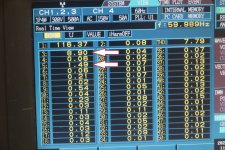Long story short (tldr) – the experiment to create the 3rd leg from L1 and L2 of a 3 phase supply using a Delta-Wye transformer worked. Though it’s certainly not a perfect waveform as if it were delivered from your local friendly POCO.
As I understood it, the theory discussed here is to use L1/L2 AND the Neutral, in order to energize 2 windings on the Wye side. These windings would, in turn, (sorry, bad pun) magnetize the corresponding 2 windings on the Delta side which would then energize the 3rd Delta winding, since those are all connected in series. Energizing the 3rd Delta winding would then magnetize the remaining coil back over on the Wye side, thus creating the L3 leg.
I used 2 random legs of our shop 208Y/120 VAC supply to create a 3 wire feed to a generic 30 kVA 480D – 208Y step down transformer. Nothing connected to the HV Delta side. Connected shop supply L1 to X1, L2 to X2 and the supply Neutral to XO. Then hooked up a small ¾ HP gear motor to L1/L2/L3, anticipating the created L3 leg would work with the shop L1/L2 legs to power the motor. And it did.
A quick detour here about the neutral. Clearly the connection to XO is crucial, without it the L1-L2 supply is simply a single phase sine wave. It’s the Neutral reference that allows L1 and L2 to have (120 degree) phase angles established between them. But this is where I ran into a little bit of hesitancy. I was always taught to never connect the XO when backfeeding a Delta-Wye transformer like this. And this is, more or less, what we are doing here. There was a long thread a month or two ago about if this really was something to be avoided or not. I did not chime into that discussion, since I felt that smarter brains than mine were hashing it out. However, I always thought that if the balance between the supply phases and supply neutral was not perfectly matched by the “balance” of the 3 Wye transformer windings and their XO (and it never is) then you can create large neutral currents as they try and fight to locate a common mid-point. When I was first wiring this experiment up, I backfed all the POCO legs to X1/X2/X3 and measured the difference between my supply Neutral and the floating XO (normally the new SDS neutral when the Wye side is the secondary). It was around 4 or 5 volts. So no perfect balance there, not terrible, but not tiny. Then, with all 3 supply legs still hooked up, I connected the supply neutral to the XO and, when powered up and idling, it carries ~16 amps (measured with an old Fluke 322) presumably because of this imbalance between the POCO legs and the transformer windings. The 3 supply phases showed around 7 amps for idle current.
I then I removed the X3 leg and taped it off for this experiment. With the transformer powered on and “idling” (no motor load) that supply neutral carries ~18 amps. Just thought to mention this XO neutral current, as it made me somewhat nervous.
Here is a snapshot of the setup…

I used an old Hioki Power analyzer for displaying voltage and current waveform(s). Note - the current data pictured is only for the 3/4 HP motor load – not the motor load and transformer magnetizing current. Also note that I looped the motor leads around the clamps 2x, to get double the current reading. So where you see 3.2 amps motor draw, it’s really 1.6. The pictured current waveforms are still too small to be of any real use.
You can see here the display of motor voltage (measured to gnd) and current, using this experiment to derive the L3 leg…
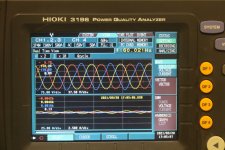
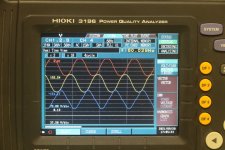
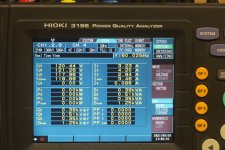
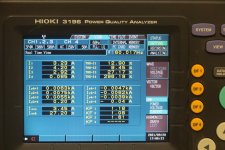
The blue line is the L3 phase created by this setup. To my eye it has some distortion, especially around the top and bottom - this is also clearly measured in the THD in the last picture above. It’s slightly more peaked than the smooth(er) sine waves on L1 and L2. And the sides connecting the min and max peaks are straighter than the L1 and L2 POCO legs. It really looks like it is morphing into a sawtooth wave, maybe the 2 magnetic "couplings" that created it (from Y->D, then back again from D->Y) added some small distortion shaping? Also, obviously, there is some voltage imbalance here and associated current imbalance on the motor windings. Nothing you’d want to run 24/7 on a larger loaded motor with. Presumably, I could try and compensate for some of this imbalance by adjusting taps. Since this is a Delta-Wye Stepdown, the taps are on the Delta side – so I’d have to scratch my head for a bit before knowing which tap to try first and in which direction to move it. And then I'd simply guess anyway

Other current data of interest, measured with my Fluke (so not artificially doubled)…
Supply current on L1 (Black) 10.7A idle 12.3A motor running
Supply current on L2 (Red) 9.1A idle 11.8A motor running
Supply current on XO (White) 18.3A idle 21.4A motor running
At any rate, this is what I found out today. You can clearly create the 3rd leg using this setup. Not elegant, but it worked. If you needed the missing leg only for dumb motors, you’d be better off using a VFD I’d think (single phase or de-rated 3 phase unit). And I did not like connecting the XO up – though it was clearly necessary for this experiment. I feel like you’d be creating unnecessary current flow (and transformer heating) trying to drag/align the X=0 Y=0 vector “origin” of the transformer on top of the (presumably stiffer) POCO zero point. But maybe that's up for debate?
It also might be the case that my motor load was too small (compared to the size of the xfmr) to really identify / validate any of the mathematical predictions that were made above (like Synchro’s). But I simply wanted to start easy and small so as to minimize any risk.






